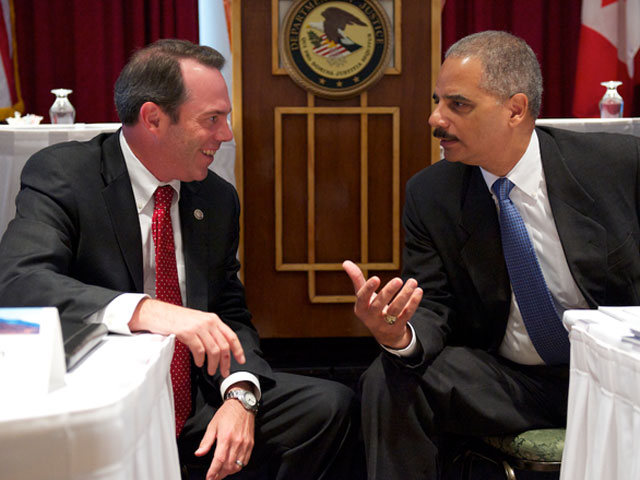Homeland Security
"The Department has improved significantly its ability to identify, penetrate, and dismantle terrorist plots as a result of a series of structural reforms, the development of new intelligence and law enforcement tools, and a new mindset that values information sharing, communication and prevention… Working with our federal, state, and local partners, as well as international counterparts, the Department has worked tirelessly to safeguard America and will continue to do so."
-- Attorney General Eric Holder Testifying Before the Senate Judiciary Committee, June 17, 2009

Attorney General Holder and North Dakota U.S. Attorney Tim Purdon discuss border security at the Northern Border Law Enforcement Summit on September 14, 2011.
Ten years after the terrorist attacks of Sept. 11, 2001, the United States has been defined by its resolve, its values, and the resilience with which it has overcome this tragedy. The 9/11 attacks and other acts of terrorism have failed to undermine our values or weaken our society. Americans continue to embrace democratic values and fundamental liberties, instead of fear and oppression.
As the Justice Department and the entire nation honor the memory of those who lost their lives in the 9/11 attacks, the Department remains fully committed to the fight against those who target Americans and our way of life. The best way to honor the legacies of the victims of 9/11 is to prevent further terrorist attacks on this country, which remains the highest priority and most urgent work of the Department.
Even as we pledge continued vigilance against those who target Americans, our nation can be justifiably proud of its response to these threats over the past decade. America is both stronger and safer than it was a decade ago. Ten years after 9/11, al-Qaeda and its affiliates, while still a serious threat, have a severely degraded capability to attack our homeland. As a result of offensive actions abroad and vigilant security measures at home, the U.S. government has reduced terrorists’ capabilities to perpetrate spectacular attacks on American soil.
For its part, the Department has improved its ability to identify, penetrate, and dismantle terrorist plots as a result of a series of structural reforms; the development of new intelligence and law enforcement tools; and a new mindset that values information sharing and prevention, while vigorously protecting civil liberties and privacy interests. Working with partners in the intelligence community, the military and law enforcement, as well as with communities across America and counterparts around the world, the Department has not rested -- and will never rest -- in its efforts to safeguard America.
Even as we strive to thwart 100 percent of the plots against us, we know that violent extremists need only succeed once. While absolute security is not possible and much work remains to be done, the Justice Department and its partners have built a much stronger security architecture to maximize our ability to protect the homeland, and are constantly adapting operations in a way that enhances the nation’s security while further delegitimizing the actions of terrorists.
Ten Years Later: Justice Department after 9/11
http://www.justice.gov/911/
United States Attorney Tim Purdon Speaks Regarding Violent Extremism
U.S. Attorney Tim Purdon delivered a speech regarding the prevention of violent extremism in North Dakota at the 9/11: Impact on the Heartland symposium held at Bismarck State College on September 10, 2011. The speech detailed the manners in which terrorist activity can reach North Dakota, and spelled out a strategy to eliminate these threats through community outreach.
“I think we have the idea that, here in North Dakota, we are protected by the many miles that separate us from recent terrorist targets like Times Square and the New York Subway System.
I think that many North Dakotans think that, because of our isolation from the coasts and the relative lack of diversity here, we need not be concerned about the threat of violent extremism.
However, it is my belief that the threat from violent extremists such as al-Qa’ida, its affiliates, and those it seeks to inspire, has changed in the years since 9/11 and that we in North Dakota are, in fact, not immune from this new, changed, threat.”
To view the full text of the speech, click here for a PDF copy.
Anti-Terrorism Advisory Council
The Anti-Terrorism Advisory Council, or ATAC, brings together government and community agencies to work to detect and prevent terrorist attacks and to promote national security. The ATAC is composed of federal, state, local, and tribal law enforcement officers, first responders, and public health and safety officials.
First Assistant United States Attorney Chris C. Myers has been appointed to serve as the ATAC Coordinator for the District of North Dakota. The Council has met regularly since September 18, 2001, primarily focusing on developing a system relevant to the fight against terrorism within the North Dakota law enforcement community.
District Intelligence Specialist Terry Van Horn has been appointed to serve as the ATAC Chief Information Officer. His function is to serve as a conduit between the ATAC and all levels of law enforcement agencies: federal, state, and local. The Task Force is currently working with the local Regional Information Sharing Systems (RISS) product, MOCIC (Mid-States Organized Crime Information Center), to complete a secure email system for members of the ATAC. This system will be part of the RISS.net network so all law enforcement agencies in the District can communicate in a secure manner.
Helpful Resources
Department of Homeland Security
Homeland Security Advisory System
North Dakota Disaster Emergency System
Natural Disasters: Be Informed
Disaster Recovery Resource Center

 U.S. Department
of Justice
U.S. Department
of Justice
